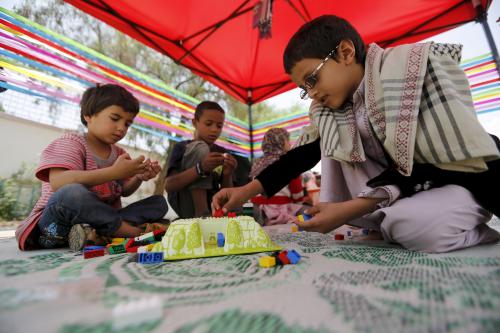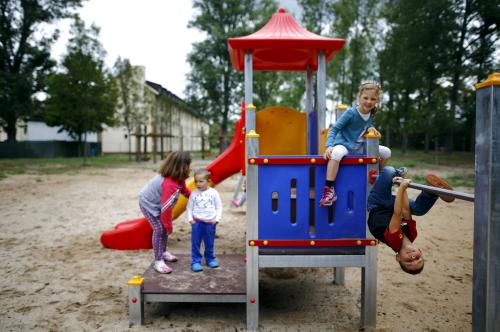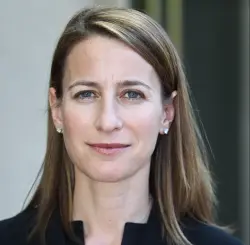This piece is a summary of the new report, “Philadelphia Playful Learning Landscapes: Scaling strategies for a playful learning movement.”
“Ah, I see what you are doing….you’re putting a children’s museum at a bus stop.”
One community member shared this astute assessment during a meeting about how to transform a street corner in the Belmont community in West Philadelphia into a space with learning opportunities for young children. The result has become known as “Urban Thinkscape,” a collaboration between the Belmont community, Temple University’s Infant and Child Laboratory, and architect Itai Palti to build engaging learning opportunities directly into places families frequently go. On what was once a regular city street corner, there are now puzzles incorporating images of Martin Luther King Jr. and other leaders into the back wall behind benches where families wait for the bus. Hopscotch specifically developed to foster impulse control is painted onto the sidewalk, and animals and other figures are hidden throughout the space, accompanied by signs that encourage conversation and storytelling between caretakers and children.
Research undertaken by the Infant and Child Laboratory, with support from the William Penn Foundation, has found that not only has the corner become a fun and engaging space for families to gather, but it has also encouraged more of the types of everyday conversations that support young children’s learning. Results from a pilot study found caregiver-child groups interacted more and had more conversations at the completed Urban Thinkscape site than they did before the installation—and in comparison to a control site playground.
This is just one example of a bigger movement happening across Philadelphia to combine what science tells us about how children learn best with efforts to redesign public spaces based on community needs. Experiments are underway to explore how to maximize “the 80 percent” of time that children spend outside of school by infusing deliberate learning opportunities into everyday spaces where families regularly gather, such as bus stops, laundromats, and supermarkets. As simple as this concept may sound, it has the potential to be revolutionary, given the vast learning challenges and inequities that children face across the country and around the world.
Philadelphia provides an important, early illustration for learning about how a city works across sectors and jurisdictions to embed playful learning opportunities into the design and landscape of the city itself—known by the broader initiative Playful Learning Landscapes.
A new report by the Center for Universal Education captures some of these insights, as well as some key recommendations for creating a playful learning movement. The intention of Playful Learning Landscapes—and the focus of the report—is to move beyond thinking about the replication of a single installation to more locations, to instead incorporate playful learning principles and design into business, government, and other organizations’ mainstream practices as a matter of course. Just like whenever a city builds a crosswalk, it is automatically equipped for the visually impaired.
Three groups of key insights—centered around scaling building blocks, strategies, and mindsets—emerged from the case study of Philadelphia, reinforced by relevant lessons from scaling other social innovations. The report highlights the essential role of local champions, partnerships, and active community engagement in sustaining and building a playful learning movement across a city. It identifies strategies to sustainably scale playful learning opportunities, including encouraging flexible adaptation when expanding playful learning interventions to new places, and—tailoring activities to local contexts without losing core scientific principles that lead to impact; it also seeks opportunities to integrate playful learning elements into existing goods and services that families already use. The report underscores the importance of considering unintended consequences of scaling and ensuring attention to and investments in sustaining a playful learning installation once developed.
Based on these insights, the report offers a set of recommendations for policymakers, implementers, funders, and researchers looking to further expand and sustain playful learning opportunities in communities and cities around the world. These include:
1. Generate robust evidence about playful learning to continue to build the evidence base and to gather data that enable continuous learning.
2. Capture and codify key elements and approaches to implement playful learning initiatives.
3. Build a coordinated global movement around playful learning.
The report concludes that collective action among policymakers, implementers, funders, and researchers around these three recommendations would help children develop the breadth of skills needed to lead healthy, safe, and productive lives by transforming everyday spaces into playful learning opportunities.
Note: The Center for Universal Education receives funding for its work on Playful Learning Landscapes from the William Penn Foundation through Temple University. The views expressed in this blog are solely those of the author.
Photo credit: Sahar Coston-Hardy







Commentary
Philadelphia demonstrates the power of play for child and city development
October 24, 2019